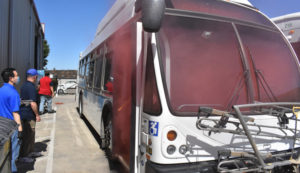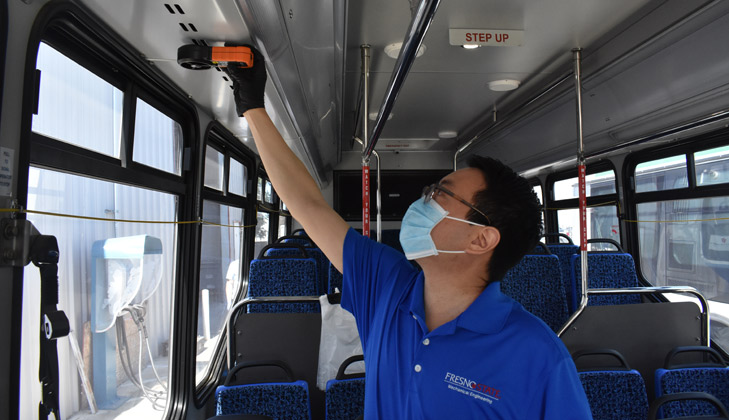Clouds of white and pink smoke loom from the windows of a large Fresno County Rural Transit Authority electric bus in a Selma transportation yard during an airflow simulation study. Sitting inside — 6 feet away from one another — is a masked, multidisciplinary team of researchers and industry professionals working to understand how the coronavirus respiratory disease (COVID-19) is spread on modes of public transportation. The smoke generated by non-toxic candles is being used to simulate the movement of airflow and airborne contamination — one of many tests being used to understand and quantify both air circulation as well as virus mitigation inside the bus.
“This study aims to understand air circulation patterns inside the cabins of busses, as well as test the impact of different approaches in mitigating potential virus circulation and infection,” said Dr. Aly Tawfik, associate professor of civil engineering in the Lyles College of Engineering at Fresno State and founding director of the Fresno State Transportation Institute. “COVID-19 has changed the world and our lives dramatically. As shelter-in-place policies ease, life is expected to slowly return to some level of normalcy. However, the virus will not have gone away. People will start sharing tight spaces on limited capacity public transportation modes such as busses, metros, trains and planes. HVAC systems are likely to just redistribute the air and airborne virus throughout the entire cabin, risking the health of both drivers and passengers.”
Dr. Juris Grasis, assistant professor in molecular and cell biology at University of California, Merced, and other members of the research team will use smoke candles and viruses that infect bacteria (that are not harmful to humans) to simulate coronavirus spread.
 “We will use two different bacteria viruses, bacteriophages, as a proxy for infectious particle circulation and mitigation,” Grasis said. “Additionally, the team is using different approaches to evaluate preventing and eliminating viruses from spreading in public transportation modes; e.g. creating positive air pressure inside the cabin, using HEPA filters, using concentrated UV exposure combined with charged carbon filters in the HVAC systems, using photocatalytic oxidation technology, and using surface antiviral agents.”
“We will use two different bacteria viruses, bacteriophages, as a proxy for infectious particle circulation and mitigation,” Grasis said. “Additionally, the team is using different approaches to evaluate preventing and eliminating viruses from spreading in public transportation modes; e.g. creating positive air pressure inside the cabin, using HEPA filters, using concentrated UV exposure combined with charged carbon filters in the HVAC systems, using photocatalytic oxidation technology, and using surface antiviral agents.”
Additional tests include testing of air speed, temperature, relative humidity and CO distributions; pressure differentials; airborne particle counts; 3D numerical simulation models; and virus numbers and their infectious abilities. Dr. Deify Law, associate professor of mechanical engineering in the Lyles College is also working to provide full HVAC data including air and smoke circulation behavior, air speed, static pressure, temperature, and relative humidity inside a transit bus using a computational fluid dynamics (CFD) model. The CFD simulations will be compared with field experiments to validate the research findings.
“This will allow us to investigate the dynamics of ventilation flow and the airborne contamination in the condition of a COVID-19 infected person who was breathing or coughing inside a transit bus,” Law said. “I am very optimistic that this research will make an impact on the future of public transportation. I see now is the time to reevaluate the HVAC design of public transportation, especially the locations of supply and return air grilles relative to the seating area of the driver and the passengers.”
Industry partners include Moe Salem, chief technology officer for Air2O Cooling, LLC, who has developed the design experiments for the various HVAC components and will also analyze the experiment results and data. Joseph Oldham, former Calstart, Inc. director for the San Joaquin Valley and early instigator of the study, is serving as the liaison between the research team, transit agencies and transit bus manufacturers. He will also provide support for dissemination of the published results. Valley mechanical contractor Energy Smart Engineering, Inc. is responsible for setting up and conducting the experiment and collecting the data.
“The study is primarily funded by the California State University Transportation Consortium,” Tawfik said. “We couldn’t do this without the generous support from industry members and area transit operators from Fresno County Rural Transit Authority and Clovis City Transit who are providing busses and staff for the testing.”
The team will later perform experiments under a variety of vehicle conditions, such as having the bus stationary and in motion, with the door and windows open and shut, and with HVAC in cooling and heating operations. “Once complete, further experiments will be performed on a variety of public transit vehicles with different HVAC configurations,” Tawfik said. “Results of this study could be significantly valuable and directly lead to improved protection of passengers and drivers on public transportation modes against all forms of air-borne viruses both locally as well as across the entire globe.”





